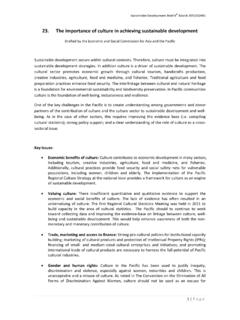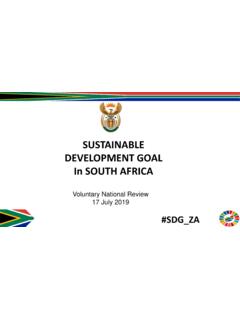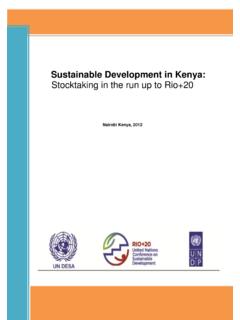Transcription of Humanitarian principles and international humanitarian ...
1 Humanitarian principles and international Humanitarian coordination mechanisms012 Contents Chapter 1 Humanitarian principles and international Humanitarian coordination mechanisms Introduction Humanitarian principles Key Humanitarian issues When to engage? Humanitarian emergencies and public health events Humanitarian coordination Global Health Cluster WHO responsibilities as Global Health Cluster lead agency Global Health Cluster vision and mission Guiding principles of the Global Health Cluster Humanitarian reform, the Transformative Agenda and new ways of working Humanitarian reform Transformative Agenda The triple nexus of Humanitarian , development and peacebuilding actors Centrality of protection in Humanitarian action What is protection mainstreaming? Health: tips for protection mainstreaming Protection from sexual exploitation and abuse Accountability to affected populations What is accountability to affected populations?
2 Incorporating accountability to affected populations into the health cluster response at country level What is the link between accountability to affected populations and protection? Mainstreaming a comprehensive people-centred approach in the health response 26 References 27 Endnotes 30 Boxes Box Humanitarian Programme Cycle 12 Box Gender-based violence 26 Figures Figure The cluster approach: clusters and lead agencies 9 Figure Humanitarian Programme Cycle in protracted emergencies 11 Tables Table Humanitarian principles and their underlying concepts 3 Table Criteria considered for initiating a scale-up activation 14 Abbreviations CHS Core Humanitarian Standard on Quality and AccountabilityFAO food and agriculture Organization of the United NationsIASC Inter-Agency Standing CommitteeIHR international Health Regulations NGO nongovernmental organizationOCHA United Nations Office for the Coordination of Humanitarian AffairsOIE World Organisation for Animal HealthSDG sustainable Development GoalUNICEF United Nations Children s FundWHO World Health principles and international Humanitarian coordination mechanisms principles and international Humanitarian coordination mechanisms suffering must be addressed wherever it is found.
3 The purpose of Humanitarian action is to protect life and health and ensure respect for human actors must not take sides in hostilities or engage in controversies of a political, racial, religious or ideological action must be carried out based on need alone, giving priority to the most urgent cases of distress and making no distinctions based on nationality, race, gender, religious belief, class or political action must be autonomous from the political, economic, military or other objectives that any actor may hold about areas where Humanitarian action is being Humanitarian principles and international Humanitarian coordination mechanisms Introduction This chapter provides a summary of how Humanitarian action has evolved in recent decades. It includes an overview of Humanitarian principles and other key global initiatives that have helped shape Humanitarian coordination. For additional information, refer to the Humanitarian response and Inter-Agency Standing Committee (IASC) Humanitarian principles Four Humanitarian principles humanity, neutrality, impartiality and independence provide the fundamental foundations for Humanitarian action and are central to establishing and maintaining access to affected populations, whether in the context of a natural disaster, an armed conflict or a complex emergency.
4 Table presents the underlying concepts on which those principles are based. Table Humanitarian principles and their underlying conceptsNote: The first three Humanitarian principles were endorsed in United Nations General Assembly resolution 46/182 of 1991, known as the Humanitarian response resolution . The fourth principle (independence) was endorsed in 2004 under resolution 58 principles and international Humanitarian coordination mechanisms principles and international Humanitarian coordination mechanisms compliance with Humanitarian principles in Humanitarian response is an essential element of effective Humanitarian coordination. United Nations agencies are mandated to embrace all four of these principles . Commitment to the four Humanitarian principles is expressed at institutional level by the majority of international Humanitarian organizations. Furthermore, globally over 450 organizations are signatory to the Code of Conduct for the international Red Cross and Red Crescent Movement and Non-Governmental Organizations (NGOs) in Disaster Relief, which includes a commitment to adhere to these Humanitarian principles (1).
5 Key Humanitarian When to engage? international Humanitarian law in all types of armed conflict whether international or non- international imposes obligations on the warring parties to use their best efforts to collect and care for the wounded and sick (2, 3).3 This means either that the parties to armed conflicts perform these medical activities themselves, traditionally through their military medical corps, or, where they are unable or unwilling to do so, that they permit others, such as the local civilian administration or impartial Humanitarian organizations, to assist them. In practice, the civilian administration is often unable to provide assistance in conflict settings, leaving victims especially civilians without access to adequate care. As a result, the World Health Organization (WHO) and Humanitarian actors increasingly find themselves in a situation where, despite multiple reminders to the parties to the conflict, victims are deprived of the health care they the warring parties and civil administration cannot carry out this role, the Global Health Cluster should look to other partners to see if they are able to engage as a first step.
6 If that is not possible, WHO can then invoke its provider of last resort obligations as the lead agency of the IASC Global Health Cluster to ensure that victims of the conflict can access lifesaving trauma care. WHO has developed operational guidance on the provision of trauma care in a conflict When necessary services are not provided in a situation where the IASC cluster system is activated, it falls upon the Global Health Cluster lead agency WHO for the health sector to serve as the provider of last resort. This means that Where necessary, and depending on access, security and availability of funding, the cluster lead, as provider of last resort, must be ready to ensure the provision of services required to fill critical gaps identified by the cluster (4). principles and international Humanitarian coordination mechanisms principles and international Humanitarian coordination mechanisms In all other situations Article 2(d) of the WHO Constitution applies, under which WHO contributes to its objective of attainment by all peoples of the highest possible level of health by furnishing appropriate technical assistance and, in emergencies, necessary aid upon the request or acceptance of Governments (5).
7 Humanitarian emergencies and public health events A Humanitarian emergency is defined as a situation impacting the lives and well-being of a large number of people or a significant percentage of a population, and requiring substantial multisectoral assistance (6, 7). A public health event is defined as any event that may have negative consequences for human health. The term includes events that have not yet led to disease in humans but have the potential to cause human disease through exposure to infected or contaminated food , water, animals, manufactured products or environments (6). Humanitarian emergencies take many forms. They may result from natural disasters, such as flooding or earthquakes, or they may be due to conflict. They may occur very quickly (acute onset) or may evolve slowly over time (slow onset). Humanitarian emergencies will also differ in duration; they may be limited to a finite time or continue over many years (continuing or protracted emergency).
8 Countries may experience repeated emergencies or face combinations of different types of emergencies, for example, an acute onset emergency in a country that is already undergoing a protracted crisis. Humanitarian coordination Humanitarian coordination involves bringing Humanitarian actors together to ensure a coherent and principled response to emergencies (8). Humanitarian coordination underpins an effective Humanitarian response. It serves to identify and meet priority needs, address gaps and reduce duplication in Humanitarian response. It facilitates the development of a Humanitarian strategy and ensures that assistance is delivered in a cohesive, principled and effective manner, following international standards and in line with the direction and objectives of the Humanitarian strategy. Humanitarian coordination also facilitates monitoring the response, with an emphasis on ensuring adherence to Humanitarian and technical quality coordination is not just about coordination of the emergency response.
9 There are critical actions to be conducted prior to the onset of an principles and international Humanitarian coordination mechanisms principles and international Humanitarian coordination mechanisms in relation to disaster risk reduction, emergency preparedness and contingency planning, capacity-building, and information management. There are also critical activities to be conducted during the emergency response to ensure that structures, standards and capacities are in place to enable a sustainable transition to a post-emergency phase, as and when appropriate, in relation to continuation of residual Humanitarian services and Global Health ClusterThe Global Health Cluster was established in 2005 under the leadership of WHO to promote and support collective action at global and country levels to ensure more effective, efficient and predictable Humanitarian health significant improvements were made following the establishment of the Global Health Cluster, nevertheless, in recognition of the need for strengthening the global capacity for Humanitarian health action, the World Health Assembly, through resolution of 2012, called on the WHO Director-General to (a)
10 Have in place the organizational capacity and resources to enable itself to discharge its function as the Global Health Cluster lead agency and assume a role as health cluster lead agency in the field; and (b) define the core commitment, core functions and performance standards of the Organization in Humanitarian emergencies, including its role as the Global Health Cluster lead agency and as health cluster lead agency in the field. The Emergency Response Framework (2013), developed by the WHO Global Emergency Management Team, explicitly mentions the Global Health Cluster as the mechanism to achieve the coordination function of WHO in WHO responsibilities as Global Health Cluster lead agencyWHO is ultimately responsible to the Emergency Relief Coordinator for ensuring the fulfilment of its lead agency role in the Global Health Cluster. At global level these responsibilities include:6 mainstreaming the cluster approach and the Transformative Agenda within WHO and promoting their understanding within WHO departments and offices at global, regional and country levels; negotiating with other United Nations agencies around cluster issues that need to be reflected in global-level documentation; principles and international Humanitarian coordination mechanisms principles and international Humanitarian coordination mechanisms engaging in advocacy at the highest levels of the IASC (including the Emergency Directors Group), and with donors and other concerned bodies, on the needs and position of the Global Health Cluster; ensuring that adequate human and financial resources and administrative structures are availed at global, regional and country levels.















